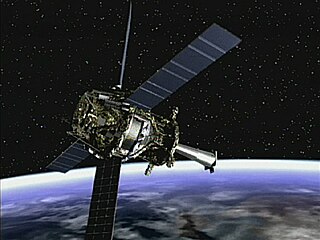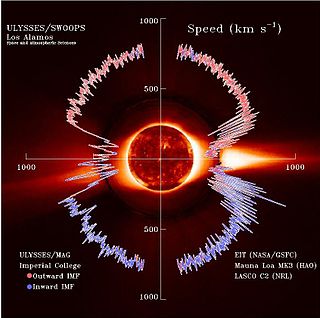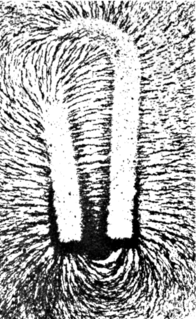
In Einstein's general theory of relativity, the gravitational redshift is the phenomenon that clocks in a gravitational field tick slower when observed by a distant observer. More specifically the term refers to the shift of wavelength of a photon to longer wavelength when observed from a point in a lower gravitational field. In the latter case the 'clock' is the frequency of the photon and a lower frequency is the same as a longer ("redder") wavelength.

The theory of relativity usually encompasses two interrelated theories by Albert Einstein: special relativity and general relativity. Special relativity applies to elementary particles and their interactions, describing all their physical phenomena except gravity. General relativity explains the law of gravitation and its relation to other forces of nature. It applies to the cosmological and astrophysical realm, including astronomy.

Loop quantum gravity (LQG) is a theory of quantum gravity, merging quantum mechanics and general relativity, making it a possible candidate for a theory of everything. Its goal is to unify gravity in a common theoretical framework with the other three fundamental forces of nature, beginning with relativity and adding quantum features. It competes with string theory that begins with quantum field theory and adds gravity.
The Breakthrough Propulsion Physics Project (BPP) was a research project funded by NASA from 1996-2002 to study various proposals for revolutionary methods of spacecraft propulsion that would require breakthroughs in physics before they could be realized. The project ended in 2002, when the Advanced Space Transportation Program was reorganized and all speculative research was cancelled. During its six years of operational funding, this program received a total investment of $1.2 million.

The Laser Interferometer Space Antenna (LISA) is a European Space Agency mission designed to detect and accurately measure gravitational waves—tiny ripples in the fabric of space-time—from astronomical sources. LISA would be the first dedicated space-based gravitational wave detector. It aims to measure gravitational waves directly by using laser interferometry. The LISA concept has a constellation of three spacecraft, arranged in an equilateral triangle with sides 2.5 million km long, flying along an Earth-like heliocentric orbit. The distance between the satellites is precisely monitored to detect a passing gravitational wave.

Gerardus (Gerard) 't Hooft is a Dutch theoretical physicist and professor at Utrecht University, the Netherlands. He shared the 1999 Nobel Prize in Physics with his thesis advisor Martinus J. G. Veltman "for elucidating the quantum structure of electroweak interactions".

Gravity Probe B (GP-B) was a satellite-based mission to test two unverified predictions of general relativity: the geodetic effect and frame-dragging. This was to be accomplished by measuring, very precisely, tiny changes in the direction of spin of four gyroscopes contained in an Earth satellite orbiting at 650 km (400 mi) altitude, crossing directly over the poles.
Gravity Probe A (GP-A) was a space-based experiment to test the equivalence principle, a feature of Einstein's theory of relativity. It was performed jointly by the Smithsonian Astrophysical Observatory and the National Aeronautics and Space Administration. The experiment sent a hydrogen maser, a highly accurate frequency standard, into space to measure with high precision the rate at which time passes in a weaker gravitational field. Masses cause distortions in spacetime, which leads to the effects of length contraction and time dilation, both predicted results of Albert Einstein's theory of general relativity. Because of the bending of spacetime, an observer on Earth should measure a different rate at which time passes than an observer that is sufficiently high up in Earth's atmosphere. This effect is known as gravitational time dilation.
The Pioneer anomaly or Pioneer effect was the observed deviation from predicted accelerations of the Pioneer 10 and Pioneer 11 spacecraft after they passed about 20 astronomical units (3×109 km; 2×109 mi) on their trajectories out of the Solar System. The apparent anomaly was a matter of much interest for many years, but has been subsequently explained by an anisotropic radiation pressure caused by the spacecraft's heat loss.

Tests of general relativity serve to establish observational evidence for the theory of general relativity. The first three tests, proposed by Einstein in 1915, concerned the "anomalous" precession of the perihelion of Mercury, the bending of light in gravitational fields, and the gravitational redshift. The precession of Mercury was already known; experiments showing light bending in line with the predictions of general relativity was found in 1919, with increasing precision measurements done in subsequent tests, and astrophysical measurement of the gravitational redshift was claimed to be measured in 1925, although measurements sensitive enough to actually confirm the theory were not done until 1954. A program of more accurate tests starting in 1959 tested the various predictions of general relativity with a further degree of accuracy in the weak gravitational field limit, severely limiting possible deviations from the theory.
In theoretical astrophysics, the Nordtvedt effect refers to the relative motion between the Earth and the Moon which would be observed if the gravitational self-energy of a body contributed differently to its gravitational mass than to its inertial mass. If observed, the Nordtvedt effect would violate the strong equivalence principle, which indicates that an object's movement in a gravitational field does not depend on its mass or composition.
The term gravitational shielding refers to a hypothetical process of shielding an object from the influence of a gravitational field. Such processes, if they existed, would have the effect of reducing the weight of an object. The shape of the shielded region would be similar to a shadow from the gravitational shield. For example, the shape of the shielded region above a disk would be conical. The height of the cone's apex above the disk would vary directly with the height of the shielding disk above the earth. Experimental evidence to date indicates that no such effect exists. Gravitational shielding is considered to be a violation of the equivalence principle and therefore inconsistent with both Newtonian theory and general relativity.

Weightlessness is the complete or near complete absence of the sensation of weight. This is also termed zero-g, although the term is more correctly "zero g-force." It occurs in the absence of any contact forces upon objects including the human body.
Zero-drag satellites or equivalently "drag-free satellites" are satellites where the payload follows a geodesic path through space only affected by gravity and not by non-gravitational forces such as drag of the residual atmosphere, light pressure and solar wind. A zero-drag satellite has two parts, an outer shell and an inner mass called the proof mass. The proof mass floats freely inside the outer shell, while the distance between the outer shell and the proof mass is constantly measured. When a change in the distance between the outer shell and the proof mass is detected, it means that the outer shell has been influenced by non-gravitational forces and moved relative to the proof mass. Thrusters on the outer shell will then reposition the outer shell relative to the proof mass so that its distance is the same as before the external influence changed it. The outer shell thus protects the proof mass from nearly all interactions with the outside that can cause acceleration, except those mediated by gravity, and by following the proof mass, the outer shell itself follows a geodesic path.

Frame-dragging is an effect on spacetime, predicted by Einstein's general theory of relativity, that is due to non-static stationary distributions of mass–energy. A stationary field is one that is in a steady state, but the masses causing that field may be non-static, rotating for instance. More generally, the subject of effects caused by mass–energy currents is known as gravitomagnetism, in analogy with classical electromagnetism.

In theoretical physics, shape dynamics is a theory of gravity that implements Mach's principle, developed with the specific goal to obviate the problem of time and thereby open a new path toward the resolution of incompatibilities between general relativity and quantum mechanics.
In physics, a non-relativistic spacetime is any mathematical model that fuses n–dimensional space and m–dimensional time into a single continuum other than the (3+1) model used in relativity theory.













